12 Customizing with the Autofocus Menu
This chapter contains descriptions of some of the more esoteric options available for the complex autofocus systems found in the EOS R7. Many of these are the settings that you’ll probably set once and forget for a while, or, at least until you decide to make a significant change in your camera’s autofocus behavior.
As much as I would have liked to present one huge, 100-page chapter on autofocus, it made more sense to describe the basic functions and settings in-depth in Chapter 5, and retain the lesser-used AF menu descriptions here with the camera’s other menus. I think the need to jump back and forth will be minimal, although, as with any camera guide, you may need a review of other chapters from time to time as a refresher.
AF Menu Options
The entries listed in the AF menus vary, depending on your shooting mode. In still photography modes other than Scene Intelligent Auto and Creative Filters modes, the full list is distributed among AF tabs numbered AF 1 to AF 6. In Scene Intelligent Auto and Creative Filters modes, a simplified roster of only 13 of those entries is available, marked with an asterisk below.
| NOTE I’ll explain the extra AF entries available in Movie mode in more detail in Chapter 16. Many of them are the same as their still photo counterparts, with additional settings to adjust Movie Servo AF speed and tracking sensitivity. |
AF 1
◼ AF Operation
◼ AF Area *
◼ Subject Tracking *
◼ Subject to Detect *
◼ Eye Detection *
◼ Switching Tracked Subjects
AF 2
◼ Servo AF Characteristics
AF 3
◼ One-Shot AF Release-priority
◼ Preview AF *
◼ Lens Drive when AF Impossible
◼ AF-Assist Beam Firing *
AF 4
◼ Touch & Drag AF Settings *
◼ Limit AF Areas
◼ Multi-controller Sensitivity/AF Point Select *
◼ Orientation Linked AF Point
AF 5
◼ MF Peaking Settings *
◼ Focus Guide *
◼ Movie Servo AF *
AF 6
◼ Electronic Full-time MF
◼ Lens Electronic MF
◼ Focus/Control Ring
◼ Focus Ring Rotation *
◼ RF Lens MF Focus Ring Sensitivity *
AF Operation
Options: One-Shot AF (default), Servo AF
My preference: N/A

Figure 12.1 The AF 1 menu.
This menu entry, the first in the AF 1 menu (see Figure 12.1) is an alternative to using the QCD or M-Fn button options to set autofocus operation. If the AF/MF switch on the camera body or lens is set to MF, then only MF appears in this entry and the other two are not available. Reminder: when focus is achieved, the focus point turns green or blue (in Servo mode); if focus cannot be achieved, the point turns orange. To recap:
◼ One-Shot AF. Single autofocus locks in a focus point when the shutter button is pressed down halfway. Green boxes will appear when the image is in focus at the active focus points, or orange if the camera is unable to achieve sharp focus. You’ll hear a beep when focus is locked in if Beep is not disabled in the Set-up 3 menu. The focus will remain locked until you release the button or take the picture. If sharp focus cannot be achieved, a picture will not be taken even if you press down the shutter release all the way.
◼ Servo AF. This continuous autofocus mode sets focus when you partially depress the shutter button, but continues to monitor the frame and refocuses if the camera or subject is moved. The focus area turns blue when focus is achieved (there is no beep), or orange if the camera is unable to focus. Pressing the shutter release down all the way takes a picture even if sharpest focus has not been achieved.
AF Area
Options: Spot AF, 1-point AF, Expand AF area, Expand AF area: Around, Flexible Zone AF 1, Flexible Zone AF 2: (Vertical), Flexible Zone AF 3 (Horizontal), Whole Area AF (default)
My preference: Whole Area AF
You can use this menu entry instead of the Quick Controls screen or M-Fn button options. You can check focus with 5X/10X (magnified views by pressing the Magnify/Reduce button in all modes).
Your choices, as explained in more detail in Chapter 5 are as follows:
◼ Spot AF. Allows you to manually select a single, reduced-size AF point.
◼ 1-point AF. Allows you to manually select a single AF point.
◼ Expand AF area. You can manually select a single AF point, as well as the four points located above, below, and to the left/right of it. In Servo mode, the camera will first focus using a single point, then track using the surrounding points if needed.
◼ Expand AF area: Around. You can manually select a single AF point, as well as up to eight points surrounding it (above, below, left, right, and diagonally from the selected point).
◼ Flexible Zone AF 1. AF points are segregated into square-shaped zones that cover about one-sixth of the frame, and you can select which zone to use. In this Zone mode and the two that follow, the camera will seek out faces and attempt to focus on them.
◼ Flexible Zone AF 2 (Vertical). AF points are segregated into larger, vertically oriented zones, and you can select which zone to use.
◼ Flexible Zone AF 3 (Horizontal). The AF points are located with a larger horizontally oriented zone that you specify.
◼ Whole Area AF. The camera selects the focus area for you, using the entire frame. For many subjects, I prefer to use this mode as my default, as it does a good job of finding subjects, particularly people, animals, or vehicles, that are moving around within the frame.
As I mentioned earlier, each of the three Flexible Zone AF areas can be resized. Press the AF point selection button, the M-Fn button, and then the AF point selection button again. Then you can make the zone wider using the Main Dial or taller with the QCD. Press the Q/SET button to confirm. To revert back to the original size, repeat the sequence above, then press the INFO button.
Subject Tracking
Options: On (default), Off
My preference: On
You can enable or disable subject tracking for individual AF area methods by pressing the INFO button when choosing that particular method. That’s gives you the option of customizing each of your AF area modes. You would use this entry only if you want to turn subject tracking on or off for all AF area Settings. There’s rarely a need for such a global on/off switch, so I usually leave this entry set at the default On. Think of it as an emergency switch for those times when you are switching among AF area modes and don’t want the camera to spend time looking for particular subjects. I explained how to use subject tracking in Chapter 5, and won’t repeat that information here.
Subject to Detect
Options: People, Animals, Vehicles, None (default)
My preference: People
This entry determines the priority for tracking subjects.
◼ People. The camera first looks for faces or heads of humans on which to focus. At some distances or shooting angles, it may have problems locating faces, and may then focus on and track parts of human bodies, such as torsos, instead. Very large or small faces, or those that are partially hidden (say, by a hat) or extremely bright or dark may not be detected.
◼ Animals. The camera is most successful seeking out faces or bodies of dogs, cats, or birds, and then focusing on/tracking them. If people are in the frame, the animals are given priority, so keep that in mind when photographing people and their active pets.
◼ Vehicles. The R7 may ignore your family sedan, but will do an excellent job of identifying the typical motor sports vehicle, including race cars and motorcycles. Press the INFO button to enable or disable Spot detection of typical key details of vehicles, such as headlights, wheels, etc. Spot detection can be useful for finding a particular vehicle if there aren’t too many overlapping.
◼ None. The camera doesn’t give focus/tracking preference to people or animals; all types of subjects have equal priority.
Eye Detection
Options: Enable (default), Disable
My preference: N/A
This setting turns human Eye Detection AF on or off, as described in Chapter 5. In use, an AF point is displayed around a detected eye. To choose which eye to focus on when AF Area is set to Whole Area AF, tap the eye on the LCD monitor. Or you can use the Multi-controller joystick to position the tracking frame on the desired eye. Temporarily disable Eye Detection AF by pressing the AF point selection button, followed by the INFO button. Press INFO a second time to reactivate Eye Detection.
Switching Tracked Subjects
Options: Initial priority, On subject (default), Switch subject
My preference: On subject
This entry determines how quickly the camera switches from one subject to another when the initial tracked subject moves out of the frame, moves behind an obstruction, or turns away from the camera. For example, if you’re shooting a football game as a running back is breaking through the line and a referee bolts along the sideline in front of you. With this feature set to Enable, the camera will very quickly switch to the ref, and then should return its attention to the running back—but often, not quickly enough. A better choice would be to use Disable, so that the camera briefly ignores the referee, who is likely to have moved on in a second or two. Focus tracking will remain on your running back. With the default value, On Subject, response is delayed.
Your options include:
◼ Initial Priority (0). At the 0 setting, the camera will lock onto the initial subject and follow it until it leaves the frame. Use this setting when you know you’ll have intervening subjects often and are certain that you want to ignore them. Many sports events fall into this category.
◼ On Subject (1). At the 1 Setting, response to movement is a bit slower, so that the camera doesn’t constantly refocus as subjects move about the frame. This is the default and should be used when there is only moderate movement, and especially if the movement is across the width or height of the frame (rather than coming toward you or away from you), and when you’re using a small f/stop, because the increased depth-of-field will eliminate the need for most re-focusing.
◼ Switch Subject (2). At the 2 setting, the camera quickly responds to new subjects that cross the frame. This is the best setting to use for fast-moving subjects, such as sports or frenetic children, as long as you don’t expect intervening subjects. The camera will smoothly follow your subjects. It works well when subjects within the frame are at significantly different distances.
Servo AF Characteristics
Options: Case 1 (default), Case 2, Case 3, Case 4, Auto
My preference: N/A
This entire menu is used to select from different factory preset “Cases” with autofocus settings suitable for various types of action scenes. You can also modify those presets to adjust the sensitivity of the camera during tracking of moving objects, its response to acceleration and deceleration, and how quickly it switches between autofocus points as subjects move through the frame.
The icons (see Figure 12.2) provide pictogram reminders showing the types of action each Case is designed to cover. Highlight the Case you want to use and press the AF point selection button. Rotate the QCD to select Tracking Sensitivity or Accellerate/Decellerate Tracking, press Q/SET again and use the directional controls to make your adjustments. Press Q/SET a final time to confirm. The camera provides helpful information about each Case at the press of the INFO button, and you can read my own recommendations for this menu in Chapter 5.
◼ Tracking sensitivity. Determines how swiftly the AF system refocuses on a new subject that enters the focus area. Your choices are –2 (Locked On) to +2 (Responsive). Negative numbers allow you to retain focus on the original subject even if it briefly leaves the area covered by the focus points, making tracking easier. Positive numbers switch more quickly to a new subject.
◼ Acceleration/deceleration tracking. Determines how the AF system responds to sudden acceleration, deceleration, or stopping. Your choices are 0 (constant speed) to 2 (sudden changes).

Figure 12.2 The AF 2 menu.
While you can adjust these parameters for any Case, you may find their default values useful:
◼ Case 1: Versatile multi-purpose setting. All-purpose setting that works well with many moving subjects, including motor sports and track, especially with subjects moving toward or away from you.
◼ Case 2: Continue to track subject, ignoring possible obstacles. Excellent for football and other sports where an intervening subject may pass in front of your primary subject. The camera will delay refocusing on the new object long enough to resume following the original subject.
◼ Case 3: Instantly focus on subjects suddenly entering AF points. Ideal when you’re photographing a static scene, waiting for a moving subject, such as the winner of a race, a skier, or bicyclist.
◼ Case 4: For subjects that accelerate or decelerate quickly. I prefer this Case for basketball and soccer because you can have players racing toward you one instant, and crossing your field of view the next.
◼ Case A: For erratic subjects moving quickly in any direction. This Automatic setting is my choice for hockey games and anything that involves skates—as well as small children and pets. It’s also excellent for that most difficult of subjects: birds in flight.
See Chapter 5 for step-by-step instructions for adjusting the values of any of the AF Cases.
One-Shot AF Release-Priority
Options: Release-priority, Focus-priority (default)
My preference: Release-priority for sports, Focus-priority for most other subjects
This is the first entry in the AF 3 menu. (See Figure 12.3.) This setting can be used to specify whether One-Shot AF uses focus-priority (the default) or release-priority. I explained the use of these alternatives in Chapter 5.
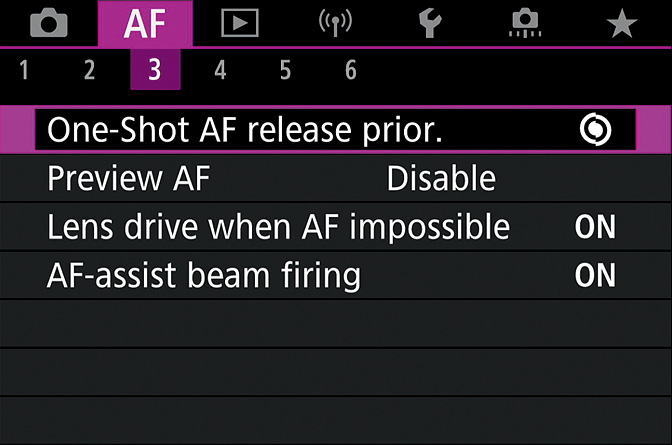
Figure 12.3 The AF 3 menu.
Preview AF
Options: Enable, Disable (default)
My preference: Disable
When Preview AF is enabled, the camera refocuses all the time (even in One-Shot mode) until you press the shutter release halfway. Then it refocuses (and locks, in One-Shot mode) and resumes refocusing (in Servo mode) until you press the shutter release all the way. The net effect is that when you’re ready to take a picture, the camera has focused and refocused continually and therefore should be ready for the final focusing when you take the photo. You’ll find that you get fewer shots per battery charge in this mode, because the continuous focus drains power as refocusing continues. Canon called this Continuous focus in previous cameras, but it was too easily confused with Servo focus, hence the name change.
Lens Drive when AF Impossible
Options: On: Continue focus search (default); Off: Stop focus search
My preference: Stop focus search
When a scene has little inherent contrast (say, a blank wall or the sky) or if there isn’t enough illumination to allow determining contrast accurately (in low light levels, or with lenses having maximum apertures of less than f/5.6), a lens may be unable to achieve autofocus. Very long telephoto lenses suffer from this syndrome because their depth-of-field is so shallow that the correct point of focus may zip past during the AF process before the AF system has a chance to register it.
Use this setting to tell the camera either to keep trying to focus if AF seems to be impossible or to stop seeking focus. Your choices are as follows:
◼ On: Continue Focus Search. The camera will keep trying to focus, even if the effort causes the lens to become grossly out of focus. Use this default setting if you’d prefer that the lens keep trying. Sometimes you can point the lens at an object with sufficient contrast at approximately the same distance to let the AF system lock on, then reframe your original subject with the hope that accurate focus will now be achieved.
◼ Off: Stop Focus Search. When this option is selected, the camera will stop trying to focus uselessly, allowing you to attempt to manually bring the subject into focus. This setting is best for very long telephoto lenses (around 400mm and up), because they encounter AF difficulties more than most lenses, and are less likely to benefit from extended “hunting.”
AF-Assist Beam Firing
Options: Enable (default), Disable, LED AF-assist beam only
My preference: LED AF-assist beam only
This setting determines when bursts from a compatible external electronic flash or the camera’s built-in LED are used to emit a pulse of light that helps provide enough contrast for the camera to focus on a subject. You can select Enable to use the camera’s LED or an attached Canon Speedlite to produce a focus assist beam. Use Disable to turn this feature off if you find it distracting. Keep in mind that if you select Enable and the Speedlite’s own AF-Assist Beam Firing is set to Disable, the AF-assist beam will not be emitted (the flash’s setting takes precedence).
◼ Enable. The AF-assist light is emitted by the camera’s LED or an attached, powered-up external flash whenever light levels are too low for accurate focusing using the ambient light.
◼ Disable. The AF-assist illumination is disabled. You might want to use this setting when shooting at concerts, weddings, or darkened locations where the light might prove distracting or discourteous.
◼ LED AF-Assist Beam Only. Some Canon flash units have an LED AF-assist lamp. Select this option to activate only the Speedlite’s beam. If your flash does not have an LED, the camera’s LED will be used instead. Again, if you’ve turned off the external flash’s AF-assist beam using its own controls, this function is disabled. If you’ve used any of Canon’s conventional dSLRs, you may recall that some flash units have an infrared AF-assist beam. That won’t work with mirrorless cameras because focusing is done on the sensor rather than a dSLR’s separate AF sensor. So, you’ll want to rely only on the LED version with your R7.
Touch & Drag AF Settings
Options: Touch & Drag AF: Enable, Disable (default); Positioning method: Absolute, Relative (default); Active Touch Area: Whole Panel, Right (default), Left, Top, Bottom, Top Right
My preference: When enabled, I prefer Relative Positioning and Whole Panel Active Touch Area.
This is the first entry in the AF 4 menu. (See Figure 12.4.) As I’ve mentioned before, your touch screen can be useful even when you’re working exclusively with the electronic viewfinder. When you access this entry, the screen shown in Figure 12.5 appears, giving you three options:
◼ Touch & Drag AF. Choose Enable to activate, or Disable to turn the feature off. When enabled, you can touch and drag according to the parameters that follow. A round orange frame appears in the viewfinder while you are dragging. As soon as you are satisfied with that position, lift your finger and the frame changes to a square frame and tracking of the subject begins. Press the Trash button to cancel selection of that subject.
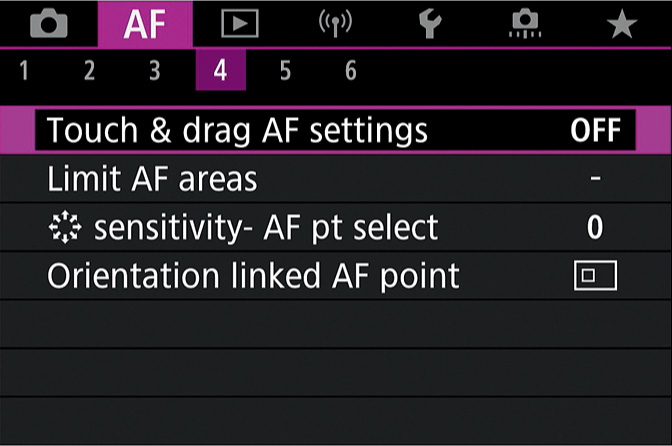
Figure 12.4 The AF 4 menu.
◼ Positioning method. You have two options for this setting:
• Absolute. While looking through the viewfinder, touch the LCD screen with a finger on the active area and drag to any position on the screen. The AF point will move to that location. This option may be more precise, but it requires you to be aware of approximately where you are touching the screen. When the active touch area (as described shortly) is the whole panel, that’s not difficult, but the behavior is more touch and go (so to speak) with smaller screen active areas.
• Relative. You can touch and drag anywhere within the active area and move the AF point in that direction by an amount corresponding to the size of the motion.
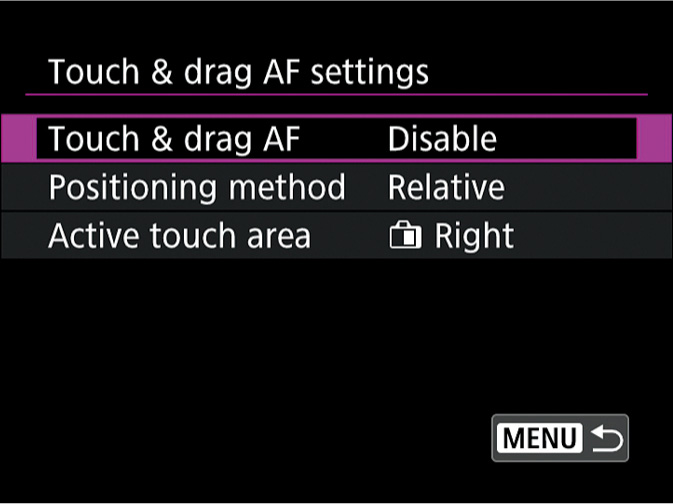
Figure 12.5 Touch & Drag options.
◼ Active Touch Area. It’s simplest if you select Whole Panel, so the entire LCD screen is active for the Touch & Drag feature. However, you can choose to make only the left, right, top, or bottom halves active, or the top-right corner. A smaller area requires less dragging to move the focus point to a particular location but is also less precise. The Whole Panel choice is generally more accurate, even if a bit slower than the alternatives.
Limit AF Areas
Options: Spot AF, 1-point AF, Expand AF area, Expand AF area: Around, Flexible Zone AF 1, Flexible Zone AF 2 (Vertical), Flexible Zone AF 3 (Horizontal), Whole Area AF (default)
My preference: All options checked
Here you can choose which of the AF-area selection modes are available. In effect, you can enable the modes you use most often, and disable those that you rarely or never work with. The 1-point AF mode cannot be disabled, however, and is displayed with a permanent checkmark.

Figure 12.6 Enable or disable any of AF Area Selection modes.
When you access this entry, a screen with all modes is displayed (see Figure 12.6). Use the QCD or directional controls to highlight a mode you want to activate/deactivate and press Q/SET. A checkmark above the icon indicates that the mode will be available. Select OK to confirm your choices. To cycle among the modes you’ve checked, press the AF point selection button on the upper-right corner of the back of the camera and press the M-Fn button until the mode you want to use is selected.
Multi-Controller Sensitivity/AF Point Select
Options: -, 0, +
My preference: N/A
If you find that the Multi-controller joystick doesn’t respond appropriately when you use it to select an AF point with your thumb, you can change the sensitivity with this setting. Choose “minus” to cause the focus point to move more slowly than normal, or “plus” to move it more quickly. This is strictly a personal preference that depends on how dexterous you are with your thumb.
Orientation Linked AF Point
Options: Same for both vertical and horizontal (default), Separate AF points: Point Only
My preference: Separate AF points: Point Only
If you have a preference for a particular manually selected AF point or Zone AF frame when composing vertical or horizontal pictures, you can specify that preference using this menu entry, by choosing Separate AF Points. Or, you can indicate that you want to use the same mode/point in all orientations (Same for Both Vert/Horiz). If you’d like to differentiate, there are three different orientations to account for:
◼ Same for both vertical and horizontal. The AF-area selection mode and the AF point or zone that you select manually are used for both vertical and horizontal images.
◼ Separate AF points: Point Only. The AF area mode remains the same regardless of camera orientation, but you can specify a different AF point in manual point selection modes for each of three orientations. The specified point will remain in force even if you switch from one manual selection mode to another. The orientations are as follows:
• Camera held horizontally. This orientation assumes that the camera is positioned so the view-finder/shutter release are on top.
• Camera held vertically with the grip/shutter release above the Mode Dial.
• Camera held vertically with the Mode Dial above the grip/shutter release.
I provided instructions for setting your focus points and illustrations in Chapter 5 and won’t repeat that information here.
MF Peaking Settings
Options: Peaking: On, Off (default); Level: High (default), Low; Color: Red (default), Yellow, Blue
My preference: On, High, Red
This is the first entry in the AF 5 menu. (See Figure 12.7.) Although located in the Autofocus 5 menu, MF Peaking Settings deals only with manual focus and is therefore available only when focusing in Manual modes. Focus peaking is a technique that emphasizes the outlines of the area in sharpest focus with a color that can be red, blue, or yellow. The colored area shows you at a glance what will be very sharp if you take the photo at that moment. If you’re not satisfied, simply change the focused distance (with manual focus). As the focus gets closer to ideal for a specific part of the image, the color outline develops around hard edges that are in focus. You can choose how much peaking is applied (High and Low), select a specific accent color (Red, Yellow, or Blue), or turn the feature off.
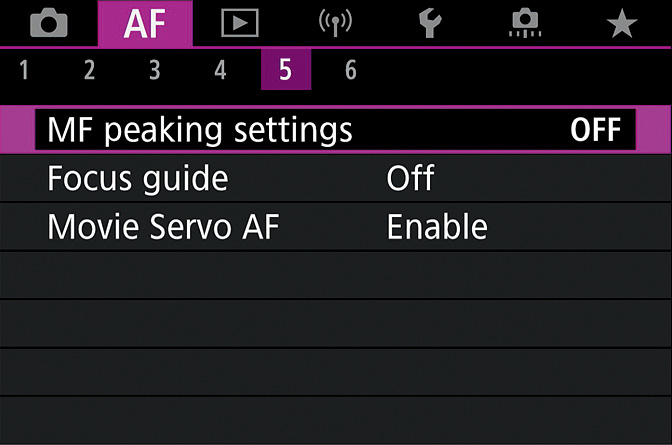
Figure 12.7 The AF 5 menu.
Peaking Color allows you to specify which color is used to indicate peaking when you use manual focus. Red is the default value, but if that color doesn’t provide enough contrast with a similarly hued subject, you can switch to a more contrasting color, such as blue or yellow. Peaking is not shown in magnified view or in the HDMI output you direct to an external monitor or recorder. It may be difficult to see the outlines at high ISO settings or when Canon Log is activated.
Focus Guide
Options: On, Off (default)
My preference: On
This is another useful manual focus (only) tool that overlays a guide within the image frame that shows you which direction you need to move the focus ring, and roughly how much. You can relocate the focus guide to a desired portion of the screen (press the AF point selection button and use the directional controls) or tap the screen to move it. Pressing the Q/SET button (or the Return icon at the upper-right corner of the touch screen) places the guide frame in the center. I provided more information on using the Focus Guide, along with illustrations, in Chapter 5.
Movie Servo AF
Options: Enable (default), Disable
My preference: Enable
This is the movie equivalent of the Preview AF feature described earlier. When active, the camera focuses on your subject all the time, without the need to press the shutter down halfway. If you temporarily don’t want the camera to focus continually, tap the Servo AF icon in the lower-left corner of the screen. Tap again to resume, or simply press the MENU or Playback buttons. It will also resume if you change the AF area. When this feature is disabled, you’ll need to hold the shutter button down halfway to focus continually; or press the AF-ON button to focus just once.
Electronic Full-Time MF
Options: Enable, Disable
My preference: N/A
This setting is the first in the AF 6 menu. (See Figure 12.8.) It enables or disables manual focus adjustment using the focusing ring when certain lenses, shown earlier under the Lens Electronic Manual Focus entry, are attached.
◼ Enable. Manual focus adjustment is available at all times when the camera is powered up, no matter what your setting is under Lens Electronic Manual focus, described earlier. In effect, this means you can always use manual focus with the listed lenses whether the camera is set for One-Shot or Servo AF.
◼ Disable. Manual focus adjustment is available only according to the settings you have made under the Lens Electronic Manual Focus setting.
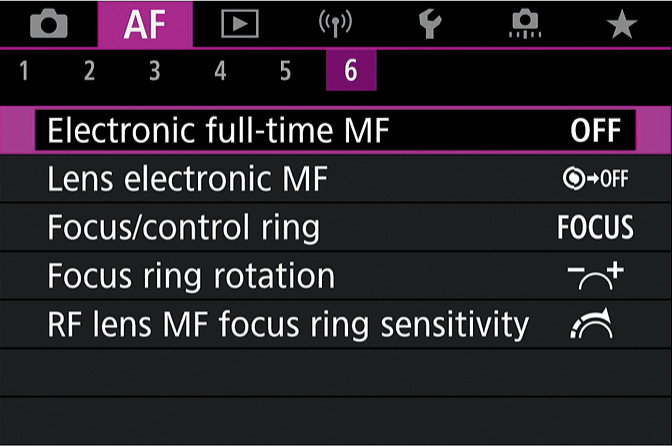
Figure 12.8 The AF 6 menu.
Lens Electronic MF
Options: Disable after One-Shot AF, One-Shot AF→Enabled (default), One-Shot AF→Disabled, Disable in AF mode
My preference: One-Shot AF→Enabled
With lenses equipped with electronic manual focusing, you can fine-tune focus after focus has been locked in using One-Shot AF. You might want to disable the use of this ring when using one of the compatible lenses, because even a casual bump against the ring can change focus significantly.
You have these choices:
◼ Disable after One-Shot AF. Manual focus is disabled. Use this when you are satisfied with the focus set by the camera’s autofocus system and don’t want to manually tweak it. Remember that if you truly want to use manual focus and bypass the AF system entirely, just slide the AF/MF switch on the lens or camera to the MF position.
◼ One-Shot AF→Enabled. When active, you can continue to hold the shutter release halfway, while adjusting focus manually.
◼ One-Shot AF→Enabled (Magnify). When active, you can continue to hold the shutter release halfway, while adjusting focus manually. Rotate the lens focus ring to magnify the area being focused as you make adjustments.
◼ Disable in AF. Turns off the feature entirely.
Focus/Control Ring
Options: Use as Focus Ring (default), Use as Control Ring
My preference: Use as Focus Ring
This entry allows you to define the function of the focus/control ring of your lens. By default, the ring functions to adjust focus manually. If you will be using autofocus full time and don’t need to make manual adjustments, you can redefine the ring to function only as a control ring, performing whatever behavior you’ve defined for the ring, as described in Chapter 14.
Focus Ring Rotation
Options: Normal (clockwise), Reverse direction (counterclockwise)
My preference: Normal
Some shooters prefer to have the focus ring rotate in the opposite direction when changing focus from near to far. Usually, they are photographers coming from another vendor, such as Nikon, that uses the reverse rotation. If you want your R7 to focus more closely when rotating clockwise, choose Normal. If you would prefer to rotate counterclockwise to focus more closely, choose Reverse Direction. My day job involves extensive use of both Canon and Nikon cameras, as well as Sony (which conforms to the Canon convention). I’ve learned to work with the rotational direction native to the system I happen to be using.
RF Lens MF Focus Ring Sensitivity
Options: Varies with rotation speed (default), Linked to rotation degree
My preference: Varies with rotation speed
Because your RF lenses use focus by wire, it was easy for Canon to program your R7 to change the degree of focus adjustment during manual focus, based on how quickly you are rotating the focus ring. When you turn the ring slowly—usually because you are fine-tuning the focus plane, perhaps during macro or portrait photography—the point of focus changes slowly. But when you turn the ring rapidly—say to follow-focus a speedy athlete—the camera focuses over a larger range for each degree you rotate the focus ring. That behavior is usually ideal, and is the default for your camera.
However, videographers have found this feature not helpful under some conditions. That’s because, unless a lens is optimized for video shooting, zooming with a particular lens may not necessarily be linear. Alternating between small focus jumps and large ones, depending on the speed of rotation, doesn’t work well when the goal is to pull or push focus. That’s a technique used during a shot to focus the viewer’s attention first on one object, and then on another one that gradually (or quickly) snaps into focus. In such cases, it’s preferable to have a given amount of rotation produce the same amount of focus change. Videographers often use accessories around the focus ring and markings that show where focus should begin and end during a shot. Linking sensitivity to rotation ensures that this refocusing happens smoothly regardless of speed.
I tend to use the default setting to vary sensitivity with rotation speed, when I am shooting stills and most video, and switch to the other option only when a more linear behavior is important.

